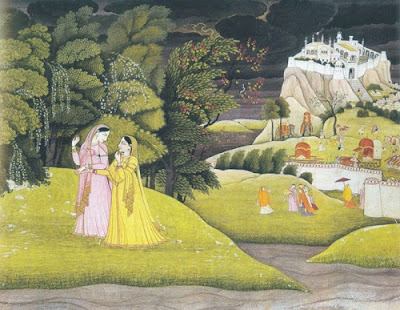.JPG) |
| Constellation of locks |
I remember the first time I encountered the lock bridge; it was a rare sunny Sunday in late January and after a filling brunch, we headed to Schenley Park for a walk before the sun went down and the ink-shroud of the winter night would envelop us. En route to the park, we had to cross a bridge - and it was then I noticed locks randomly studding the fence. By the time we reached the middle of the bridge, the fence was densely covered with a huge profusion of locks of all shapes, sizes, and colors. What was most notable about the locks was that they were either inscribed with presumably lovers' initials or single words such as 'mine'.
.JPG) |
| C+L |
I had never seen anything quite like it before - and yet, it seemed entirely organic, having seem to grow of its own accord and evolving over time. Others walked past it without giving as much a second glance, clearly accepting it as part of the urban landscape as much as the neon yellow claws graffitiing the pavement below the locks or the cars whizzing below the bridge. And then, it too slipped out of my mind...
Few days ago, when indulging in my monthly fashion magazine round-up, I glimpsed a familiar sight in the pages of Elle: bridge studded with locks. However, this particular bridge was located in Paris and it was said that lovers 'locked' their love by affixing the locks to the bridge's fence and throwing away the keys in the Seine flowing below, thus symbolising eternal love. What I thought was a curious, isolated phenomenon was in fact - not... and simply googling 'lock bridge' revealed that apart from Paris, such lock-studded bridges are found all over the world, including Rome, Venice, Brooklyn, Seoul, Taiwan, and our very own Pittsburgh.
 |
| One of the many lock bridges in Paris |
 |
| Rome: Ponte Milvio |
There are several speculations as to how this tradition developed; some attribute it to the Chinese, who believed in 'locking' souls together. The lock bridge in Rome, for example, owes to the Federico Moccia's Italian novel, I Want You in which lovers affix the locks to Ponte Milvio and throw the keys into the canal. However, authorities meanwhile see the padlocks being an eye-sore and weighing bridges down, thus necessitating being removed - and as this writer mentions here, the locks symbolise anything but love, love being synonymous with freedom.
For me, though, I perceived it as an urban shrine of sorts of lovers and for lovers; I recalled the wish trees that I had glimpsed in India and commonly appear in various avatars across the world. Here, though, the fence and locks had replaced the branches and ribbons respectively. And yet, the sense of yearning and hope radiated as strongly from the locks as they did from the ribbons.
How people engage with and insert themselves into their surroundings to create such interesting urban narratives fascinates me - and that's why I was drawn towards the lock-bridge. Thinking about it, such whimsical and honestly speaking, adorable examples of street art and installations really brighten up my day...when you are walking through man-made landscapes, you may unconsciously feel that you will not encounter as many surprises and beauties as you may do in natural environments, such as a forest or beach. However, such thinking clearly underestimate the surprises which are embedded inside the urban world - it's all a question of looking.
How people engage with and insert themselves into their surroundings to create such interesting urban narratives fascinates me - and that's why I was drawn towards the lock-bridge. Thinking about it, such whimsical and honestly speaking, adorable examples of street art and installations really brighten up my day...when you are walking through man-made landscapes, you may unconsciously feel that you will not encounter as many surprises and beauties as you may do in natural environments, such as a forest or beach. However, such thinking clearly underestimate the surprises which are embedded inside the urban world - it's all a question of looking.
And so, I will leave you with a thought-provoking surprise I encountered in downtown Pittsburgh a few days ago. Lost and late for an event, I was running helter-skelter through the streets and alternately glancing down at Google maps on my phone to locate the place I was meant to go to. However, I immediately stopped in my tracks when I saw this:
It was pasted on the window of a shop, which looked abandoned and had been for quite a while...save for this sign. Who had left it there and why? Whatever the motivations and reasons behind it, I am sure it must have compelled many passerbys to pause in their frenetic wanderings and simply reflect upon the message and the question the sign enclosed. Or as in my case, take a picture of it as a reminder and remembrance. Like a bottled message, this is a windowed message...
I found it so compelling that I could not help sharing both this picture and question across different social media networks - and I now pose it to you over here.
Where will you be standing?













